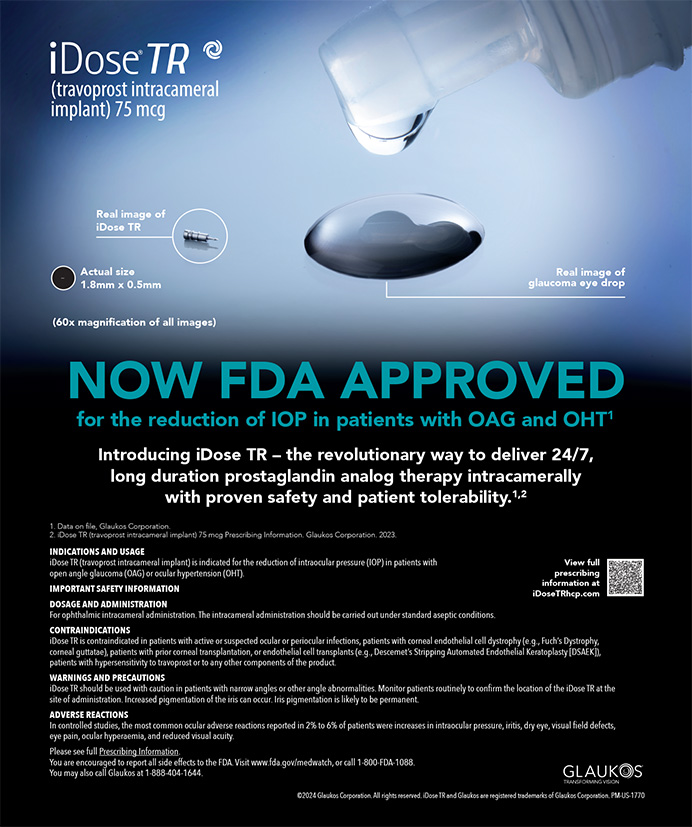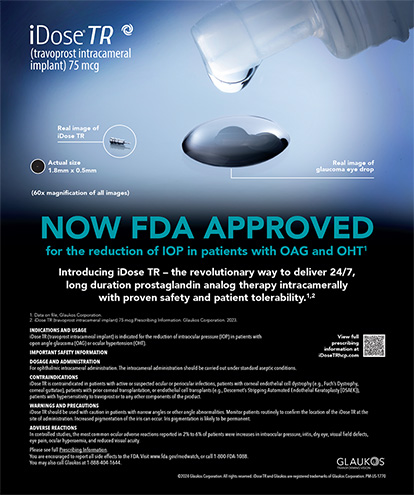By Paul S. Koch, MD
Understanding the roles of the anterior capsule and fluidics can help us to prevent most episodes of nuclear subluxation and will assist us in recovering a dropped nucleus.
PREVENTION
The Capsulotomy
In the early days of phacoemulsification, a subluxated nucleus was less common. Our techniques then were geared toward getting the nucleus up into the anterior chamber, and our biggest problem was corneal edema, not subluxation of the lens. The original Christmas tree capsulotomy was designed to open the anterior capsule as widely as possible. Then, we gently dislodged the nucleus to the side and held it firmly until its nucleus crossed midpupil—a technique rarely used today. At that point, it was clear we would be able to prolapse the nucleus into the anterior chamber.
In response to problems with corneal edema, we switched to a large can-opener capsulotomy. It allowed us to work in the bag, so to speak, but there was plenty of space for nuclear fragments—or the entire nucleus— to float up into the anterior chamber or, more importantly, away from the posterior capsule.
The point is that pressures in the eye will dislodge a nucleus posteriorly. As long as it has a release valve (ie, an escape passage into the anterior chamber), we will not have problems with the nucleus’ dropping or drawing it back up again.
As phacoemulsification evolved, we faced two complementary objectives. First, in order to reduce corneal edema, we had to keep the nucleus in the bag, away from the endothelium. Second, the first foldable IOL suitable for fixation in the capsular bag required a continuous tear capsulotomy in order to keep the lens in place. With a can-opener capsulotomy, the lens would float out of its desired position. We surgeons therefore abandoned the ragged anterior capsulotomies that gave us a release valve and adopted a continuous tear capsulotomy that left us with a firm anterior capsular barrier that held everything in the bag (Figure 1)
This transition changed cataract surgery. With our original capsulotomies, rocking the nucleus only modestly affected the bag and zonules, because the anterior capsule’s flaps would peel back, and the nucleus would glide out and in front of the bag. With a continuous tear capsulotomy, stress on the nucleus is transmitted directly to the capsule and zonules. The lack of a release valve made torn zonules and ruptured capsular bags inevitable.
Fluidics
After making tiny incisions, we pressurize the eye with an ophthalmic viscosurgical device (OVD). Moving backward like a disc on a spring, the lens and zonules absorb most of the pressure. If the capsule suddenly disappeared, the nucleus could only go in one direction, backward.
When we initiate phacoemulsification of the nucleus, inflow must be sufficient to stabilize the anterior chamber and to keep the bag inflated and the iris still. Any movement of the intraocular structures represents an error in fluidic settings. Happily, we no longer have to worry about the posterior capsule’s bouncing up into the phaco tip. Adequate inflow pressure, however, is required to hold the posterior capsule steady. Unfortunately, if the posterior capsule disappeared, the inflow pressure in the anterior chamber would propel the nucleus backward.
Sculpting is one of the leading causes of stress on the capsule and zonules. Inappropriate settings cause the nucleus to shift and rock within the bag, potentially causing trauma. The reason for sculpting is to emulsify part of the nucleus by converting it into dust and letting that dust float out of the eye. The nucleus should remain steady during sculpting; any movement means the settings are wrong.
If the phaco power is insufficient to emulsify the nucleus or if the phaco handpiece moves too quickly, the lens nucleus will move away from the tip and compress the capsule on the other side while stretching the zonules directly under the phaco tip. Slowly pulsing power will not emulsify the nucleus, which will jump toward the tip with every break between pulses of energy. It is important to remember that we do not need to attract the nucleus during sculpting, because we are emulsifying it, not pulling it in.
If the aspiration is too high or fast, the nucleus will be drawn to the phaco tip. The result is pressure on the capsule under the phaco tip and stretching of the zonules on the other side of the eye.
MANAGEMENT
When the posterior capsule tears and the nucleus begins to descend, in most cases, the vitreous will be firm enough to prevent the nucleus from dropping very far (Figure 2). Not much will happen unless we loosen or remove the vitreous or we push down on the nucleus. Unfortunately, those actions represent our impulse when we see the nucleus sinking. We remove the phaco tip and fill the eye with an OVD, which pushes down on the nucleus. No intact posterior capsule holds it in place. The nucleus will move away from the high pressure in the anterior chamber through the open capsule toward the lower pressure.
A better response is to remove the phaco tip from the eye and allow the globe to soften. As the vitreous rises, it will lift the nucleus with it. If only a chunk of nucleus dropped, we can inject an OVD underneath it so that it is trapped in the front of the eye while the vitreous is pushed backward.
If the nucleus is nearly intact and is wider than the capsulotomy, it cannot physically move more anterior than the anterior capsule, because the latter acts as a barrier. The only way to ensure that the nucleus can be lifted in front of the capsule is by cutting several relaxing capsulotomies, breaking up the intact membrane, and letting it peel back to allow the nucleus to pass through the capsulotomy (Figure 3). The same principle holds if we are going to lift the nucleus with a spatula placed through a pars plana incision (ie, the posterior assisted levitation technique). We can place the spatula underneath the nucleus and lift it. If a barrier blocks its path, however, the nucleus will soon fall off the spatula and drop. Before attempting the posterior assisted levitation technique, we must open the anterior capsule to permit the nucleus’ levitation in front of it (Figure 4).
SUMMARY
Understanding fluidics and the barrier effect offered by the anterior capsule is crucial to preventing and managing a subluxated nucleus. Today, the capsulotomy is designed to keep things behind it. As a result, when a nucleus begins to drop, we cannot salvage it while an intact capsulorhexis remains an impediment. Opening the capsule to allow the nucleus to pass through makes recovery more likely.
Paul S. Koch, MD, is the founder and medical director of Koch Eye Associates in Warwick, Rhode Island. Dr. Koch may be reached at (401) 738-4800; paulkoch@kocheye.com.
By Richard J. Mackool, MD
At the first indication of an open posterior capsule, vitreous prolapse, or posterior movement of the nucleus, I recommend proceeding in the following manner.
STEP NO. 1
Discontinue infusion (foot pedal position 0) but keep the phaco tip in the eye.
STEP NO. 2
Inject an ophthalmic viscosurgical device (OVD), preferably a dispersive type, into the anterior chamber. Use your nondominant hand to perform this maneuver through the sideport incision. Do not overinflate the chamber; the goal is to replace the balanced salt solution that is anterior to the iris with the OVD. Then, remove the phaco tip and inject additional dispersive OVD posterior to the remaining nucleus. This step is often best performed through the pars plana as follows:
•Attach a 30-gauge disposable needle to a syringe of Viscoat (Alcon Laboratories, Inc., Fort Worth, TX).
• Insert the needle through the conjunctiva and sclera 3.5 mm posterior to the limbus.
• Deliver an OVD injection of 0.5 to 1.0 mL immediately behind the nuclear material.
STEP NO. 3
Reinsert the phaco tip and use a second instrument (my favorite is a Mackool-Bechert Nucleus Rotator [Crestpoint Management Ltd., St. Louis, MO]) through the sideport incision to position the nucleus for removal by the phaco tip. For this maneuver, I recommend modest flow and vacuum levels (eg, 25 mL/min and 250 mm Hg). Some surgeons prefer to lower the infusion bottle height, but I have found no reason to do so.
Be alert for obstruction of the phaco tip by the OVD and/or nuclear material. Always verify that the tip can aspirate balanced salt solution or OVD that is adjacent to the nucleus before activating ultrasound. Otherwise, elevation of the tip’s temperature may burn the incision.
STEP NO. 4
If vitreous strands are attracted to the phaco tip, you can still remove the nucleus by phacoemulsification. If vitreous occludes the tip, however, then the instrument should be withdrawn and a vitrectomy performed prior to any further attempts at nuclear removal. Triesence (Alcon Laboratories, Inc.) can aid the visualization of the vitreous during the procedure.
STEP NO. 5
Remove the cortex. The standard fashion is appropriate in eyes that have no vitreous in the vicinity of the anterior segment. Alternatively, you may proceed bimanually through two limbal incisions. Use (1) a chamber maintainer or infusion cannula and (2) an aspirating tip or a syringe with a 27-gauge cannula attached.
STEP NO. 6
If the capsulorhexis is intact and smaller than the optic, it is highly desirable to place a multipiece IOL in the ciliary sulcus and to capture the optic in the capsulorhexis because of the stable fixation that this approach provides. The power of the IOL should not be adjusted, as it should when the lens is placed in the sulcus without capture of the optic. The effective lens position will essentially be the same as if the lens were entirely within the capsular bag.
If the capsulorhexis is too large to permit the capture of an IOL with a 6-mm optic, the implantation of an IOL with a 6.5-mm optic (eg, the AcrySof MA50 or MN50 series; Alcon Laboratories, Inc.) may permit the optic to be captured within the capsulorhexis. If the capsulorhexis is not intact but capsular support seems to be adequate, placing a PCIOL within the sulcus is appropriate.
STEP NO. 7
When inserting the IOL, it may be wise to tie a suture to the trailing haptic until the lens is safely located at the desired position. The suture can then be cut as it passes beneath the iris sphincter. Of course, should capsular support be inadequate for the insertion of a PCIOL, a sutured PCIOL and an ACIOL are reasonable options.
STEP NO. 8
Refer the patient to a vitreoretinal surgeon if the removal of posteriorly dislocated nuclear material is required.
STEP NO. 9
Because the eye may have more inflammation and a greater risk of postoperative cystoid macular edema than after an uncomplicated cataract procedure, prophylaxis is appropriate. I recommend treatment with a combination of steroidal and nonsteroidal topical medications as well as a long-acting cycloplegic. The cycloplegic has an anti-inflammatory effect that is additive to the steroids and nonsteroidal drugs. In my experience, the simultaneous use of these three agents greatly reduces the incidence and severity of cystoid macular edema after complex ocular procedures such as surgery for a dropped nucleus.
Richard J. Mackool, MD, is the director of The Mackool Eye Institute and Laser Center in Astoria, New York. He is a consultant to Alcon Laboratories, Inc. Dr. Mackool may be reached at (718) 728-3400, ext. 256; mackooleye@aol.com.


